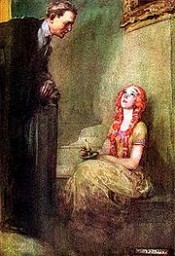Colum Padraic

William Andrew ("Willy") Pogany (1882-1955) was a Hungarian prolific illustrator of children's and adult books. Born Vilmos Andreas Pogany in Szeged, Hungary. He studied at Budapest Technical University and in Munich and Paris.[1] Pogany came to America via Paris and London. In London, he produced his four masterpieces, Samuel Taylor Coleridge's The Rime of the Ancient Mariner (1910), Richard Wagner's Tannhauser (1911), Parsifal (1912) and Lohengrin (1913). In 1918 he illustrated a children's rewrite of Homer, The Adventures of Odysseus and the Tale of Troy, retold by Padraic Colum. Pogany's best known works consist of illustrations of classic myths and legends done in the Art Nouveau style. He also worked as an art director on several Hollywood films, including Fashions of 1934 and Dames. Asked how to say his name, he told The Literary Digest that in America it was po-GAH-ny. "However, in my native Hungary this name is pronounced with the accent on the first syllable with a slightly shorter o and the gany is as the French -gagne (the y is silent)": PO-gahn.[2] In his 1952 autobiography Witness, Whittaker Chambers described "Willi Pogany" ("long a scene designer at the Metropolitan Opera House") as the brother of Joseph Pogany.[3] Willy Pogany sued Chambers for $1 million but lost in court[4] and appeals.[5]. According to TIME, "A lower court had found that Chambers, in his mistaken identification, had not maliciously implied that Willy was closely associated with 'a Communist leader and spy'," who had been "once (until Stalin liquidated him) Communist Hungary's puppet Commissar of War."[5] Pogany's public art can be seen on the walls of the Ringling Mansion in Sarasota, FL, the theatre of the Museum of the City of New York, and the Bernard B. Jacobs Theatre on 45th St in NYC
do you like this author?
What readers are saying
What do you think? Write your own comment on this book!
write a commentWhat readers are saying
What do you think? Write your own comment on this author!
write a commentBook list

The Golden Fleece and The Heroes Who Lived Before Achilles
Series:
Unknown
Year:
Unknown
Raiting:
3.5/5
Show more
add to favoritesadd In favorites

The Golden Fleece and The Heroes Who Lived Before Achilles
Series:
Unknown
Year:
Unknown
Raiting:
3.5/5
Show more
add to favoritesadd In favorites

The Children of OdinThe Book of Northern Myths
Series:
Unknown
Year:
Unknown
Raiting:
4.5/5
Show more
add to favoritesadd In favorites
Book list

The Golden Fleece and The Heroes Who Lived Before Achilles
Series:
Unknown
Year:
Unknown
Raiting:
3.5/5
Show more
add to favoritesadd In favorites

The Golden Fleece and The Heroes Who Lived Before Achilles
Series:
Unknown
Year:
Unknown
Raiting:
3.5/5
Show more
add to favoritesadd In favorites

The Children of OdinThe Book of Northern Myths
Series:
Unknown
Year:
Unknown
Raiting:
4.5/5
Show more
add to favoritesadd In favorites

The Golden Fleece and the Heroes Who Lived Before Achilles
Series:
Unknown
Year:
Unknown
Raiting:
3.5/5
Show more
add to favoritesadd In favorites

The Boy Who Knew What The Birds Said
Series:
Unknown
Year:
Unknown
Raiting:
4.5/5
Padraic Colum (1881-1972) was an Irish poet, novelist, dramatist, biographer and collector of folklore. He was one of the leading figures of the Celtic Revival. At the age of seventeen, he passed an exam for and was awarded a clerkship in the Irish Railway Clearing House. He stayed in this job until 1903. During this period, Colum started to write and met a number of the leading Irish writers of the time. His earliest published poems appeared in The United Irishman. His first book, Wild Earth (1907) collected many of these poems. In 1911 he founded the short-lived literary journal The Irish Review. In 1914, Colum travelled to the USA where he took up children's writing and published a number of collections of stories for children, beginning with The King of Ireland's Son (1916). In 1922 he started writing novels. Amongst his other works are Three Plays (1916), The Boy Who Knew What the Birds Said (1918), The Children of Odin: The Book of Northern Myths (1920) and The Golden Fleece and the Heroes Who Lived Before Achilles (1921).
Show more
add to favoritesadd In favorites

The Adventures of Odysseus and The Tales of Troy
Series:
Unknown
Year:
Unknown
Raiting:
3/5
Show more
add to favoritesadd In favorites
What readers are saying
What do you think? Write your own comment on this author!
write a commentGenre
- Nonfiction / Politics / General
- Literature & Fiction
- Literature & Fiction / Contemporary
- Books / United States / History / War of 1812
- Books / Epic literature, Irish
- Arts & Photography / Performing Arts / Theater / Acting & Auditioning
- Books / Actors / Great Britain / Correspondence
- Books / Communication in the environmental sciences / Periodicals
if you like Colum Padraic try:
readers also enjoyed
What readers are saying
What do you think? Write your own comment on this author!
write a commentGenre
- Nonfiction / Politics / General
- Literature & Fiction
- Literature & Fiction / Contemporary
- Books / United States / History / War of 1812
- Books / Epic literature, Irish
- Arts & Photography / Performing Arts / Theater / Acting & Auditioning
- Books / Actors / Great Britain / Correspondence
- Books / Communication in the environmental sciences / Periodicals
if you like Colum Padraic try:
readers also enjoyed
Do you want to read a book that interests you? It’s EASY!
Create an account and send a request for reading to other users on the Webpage of the book!

